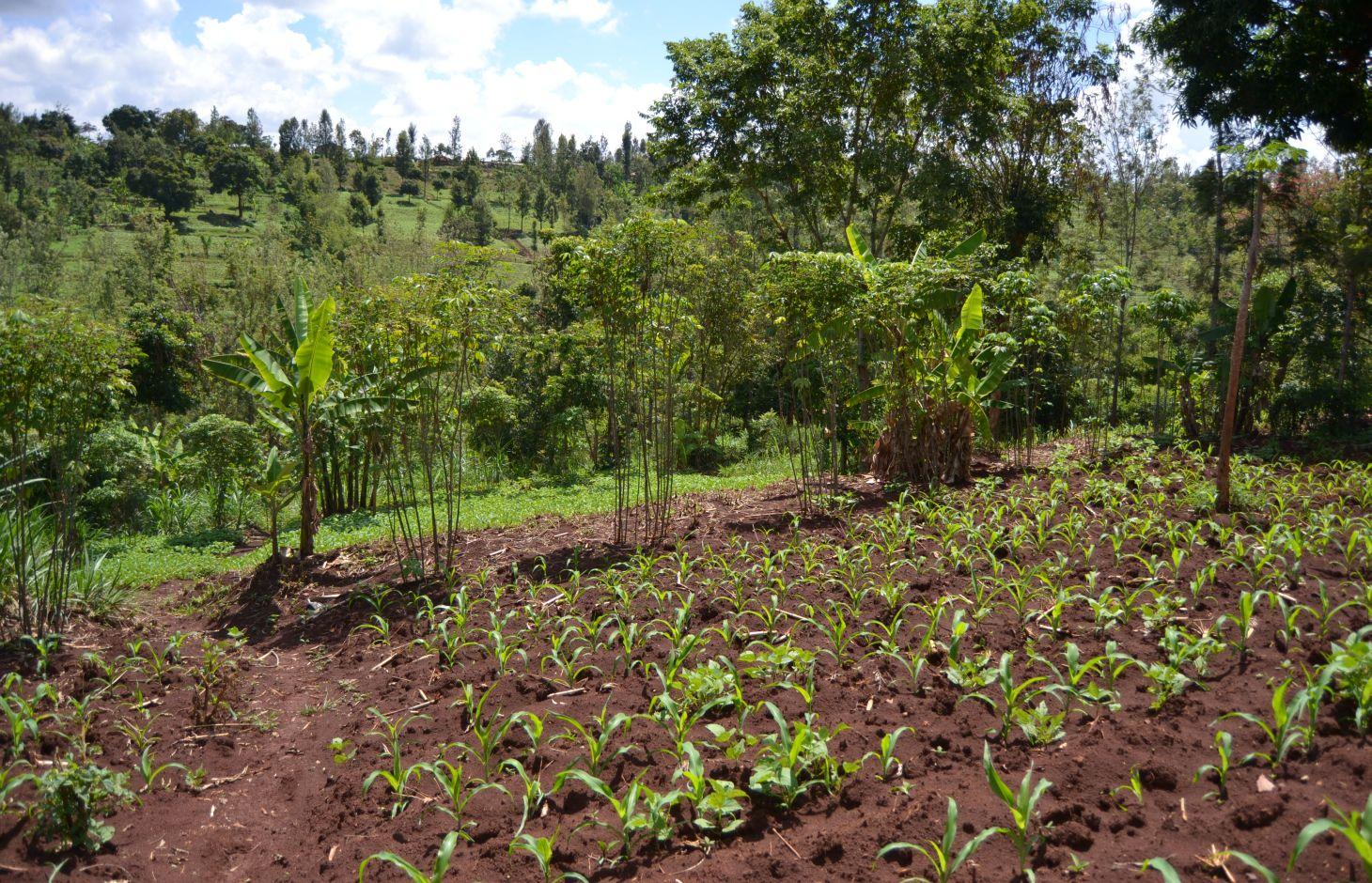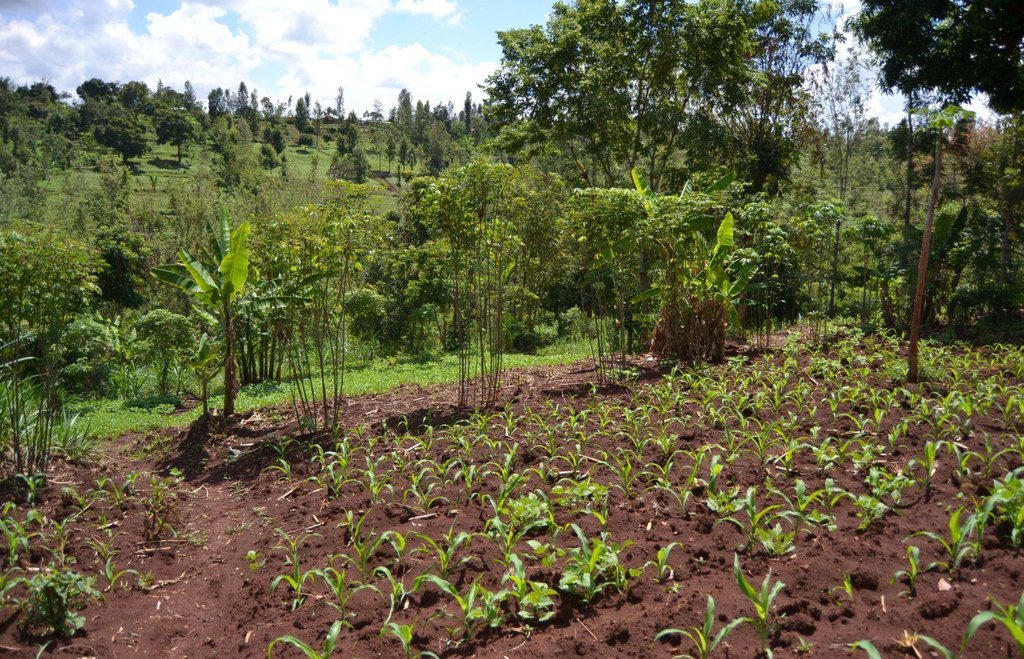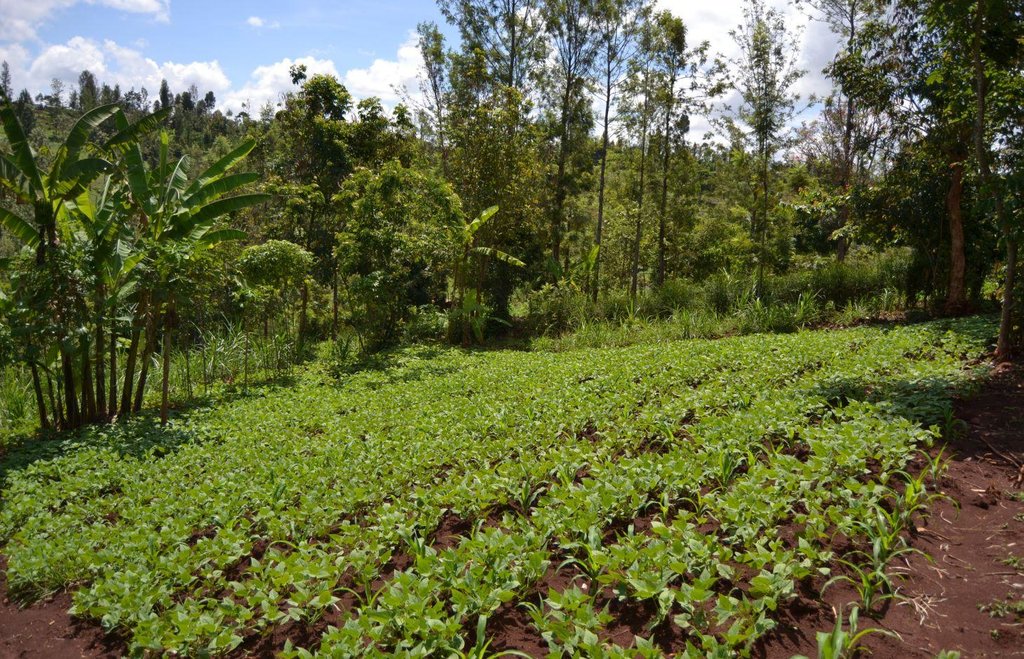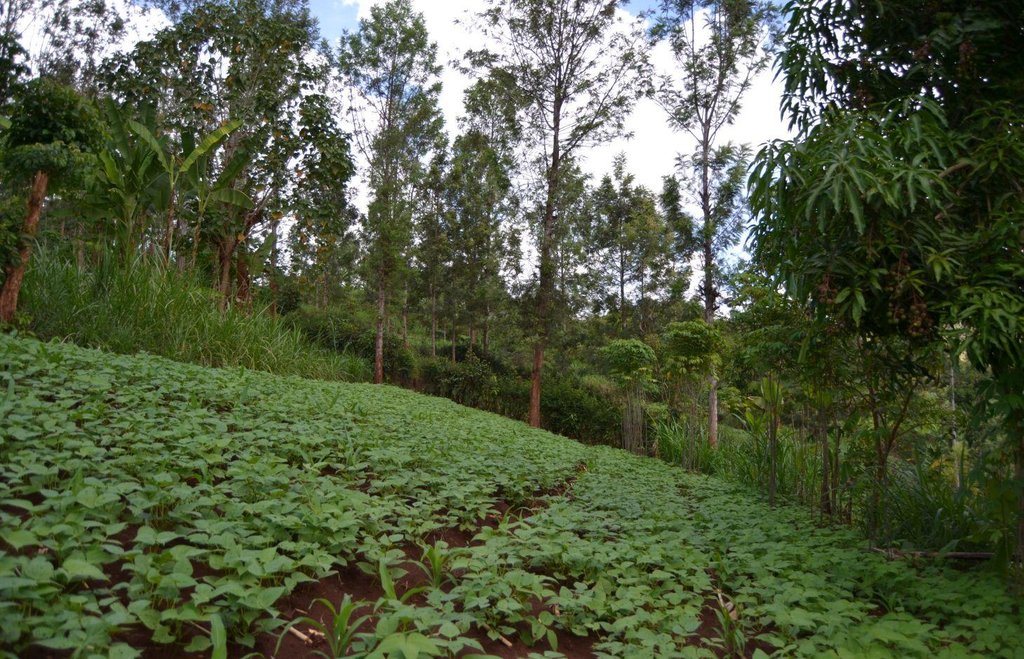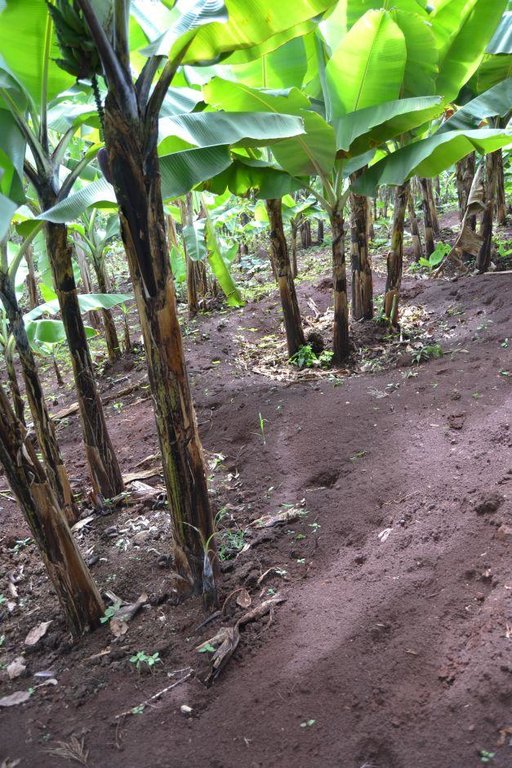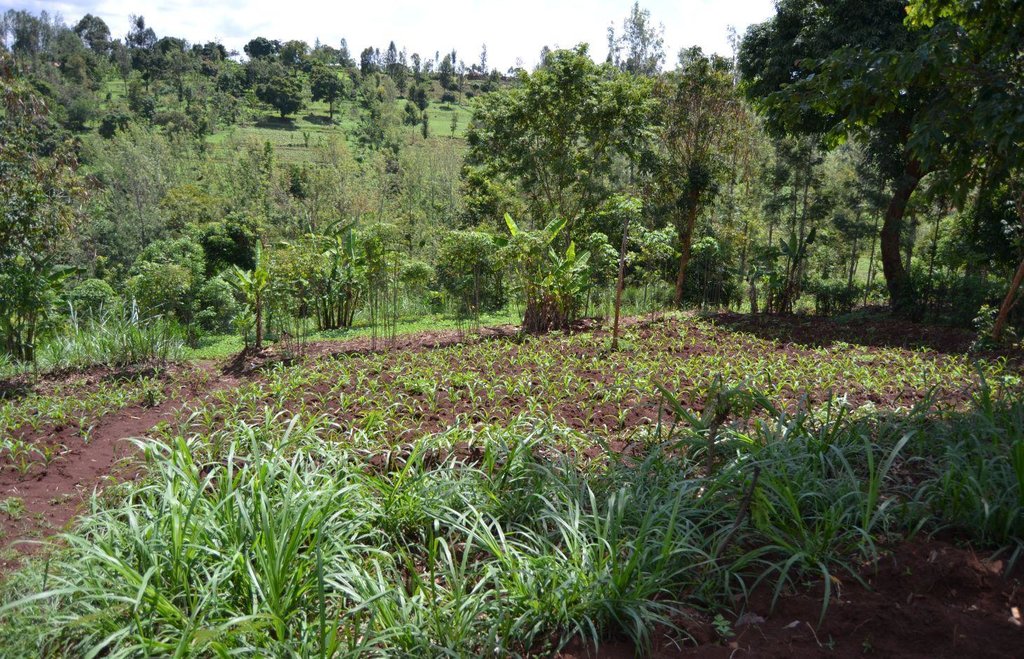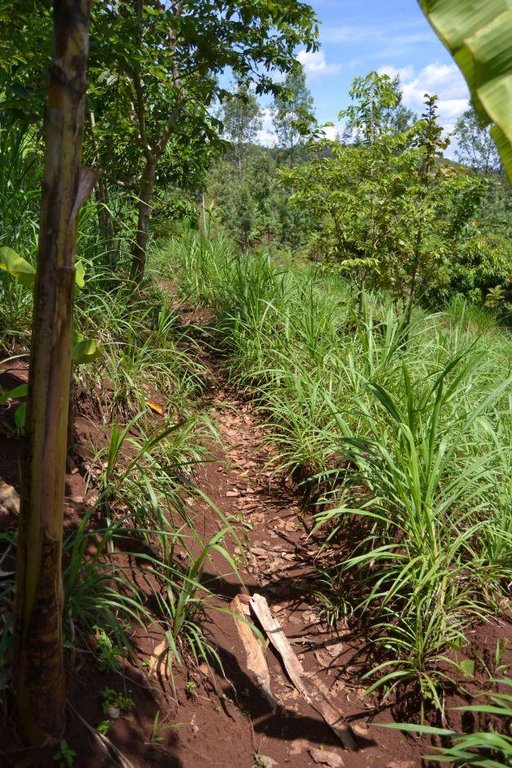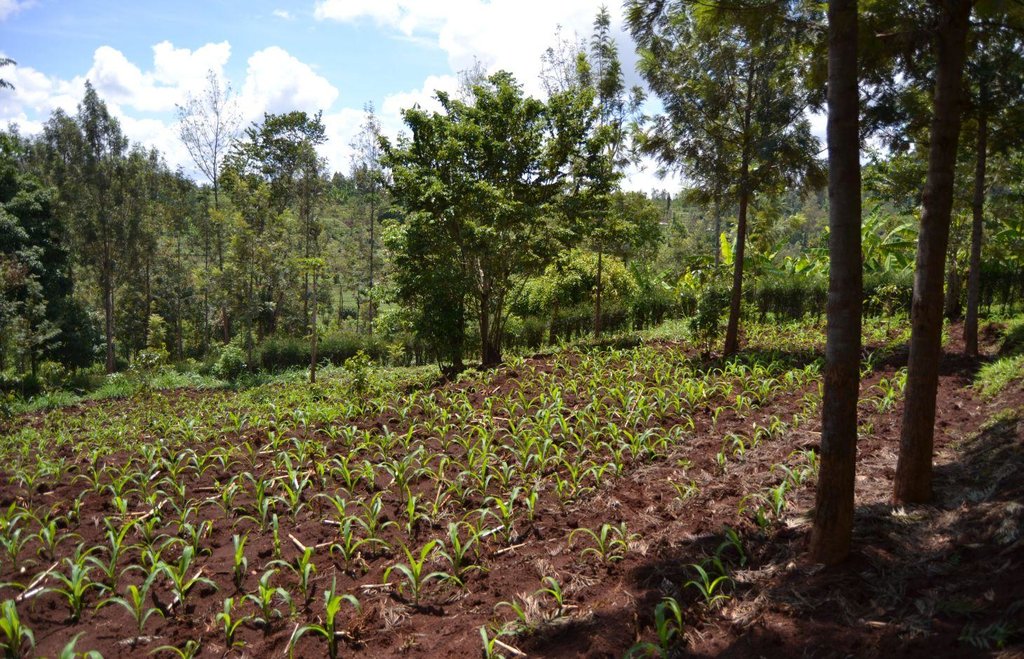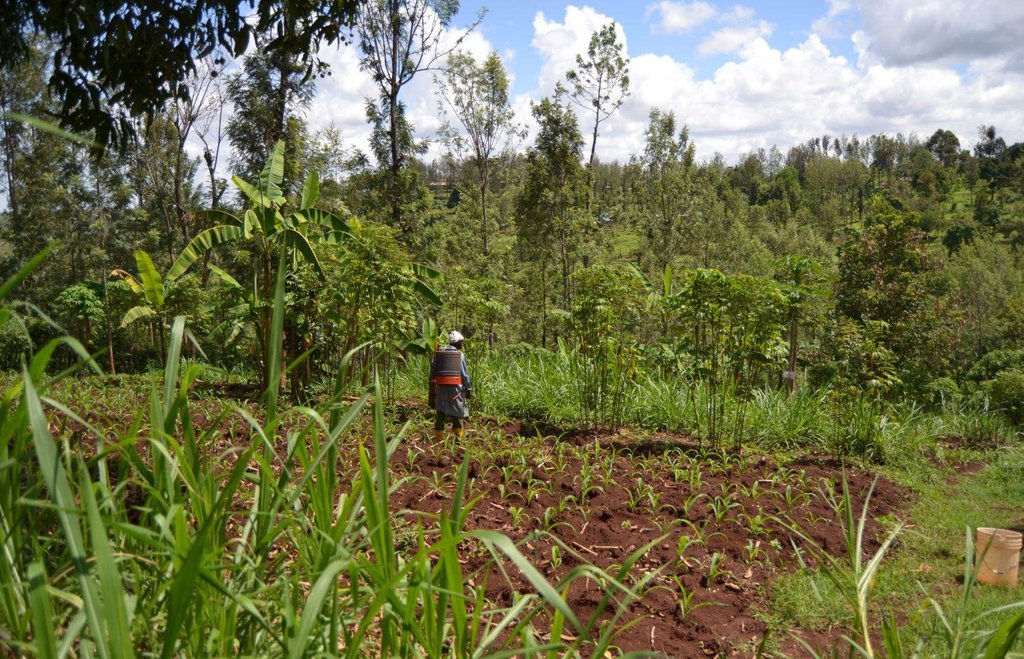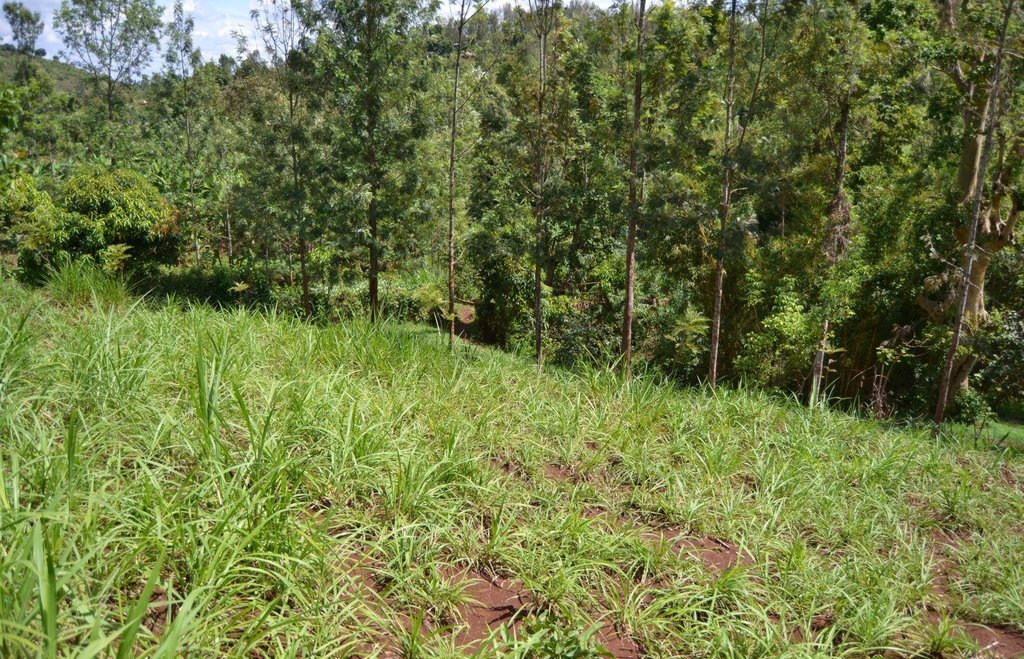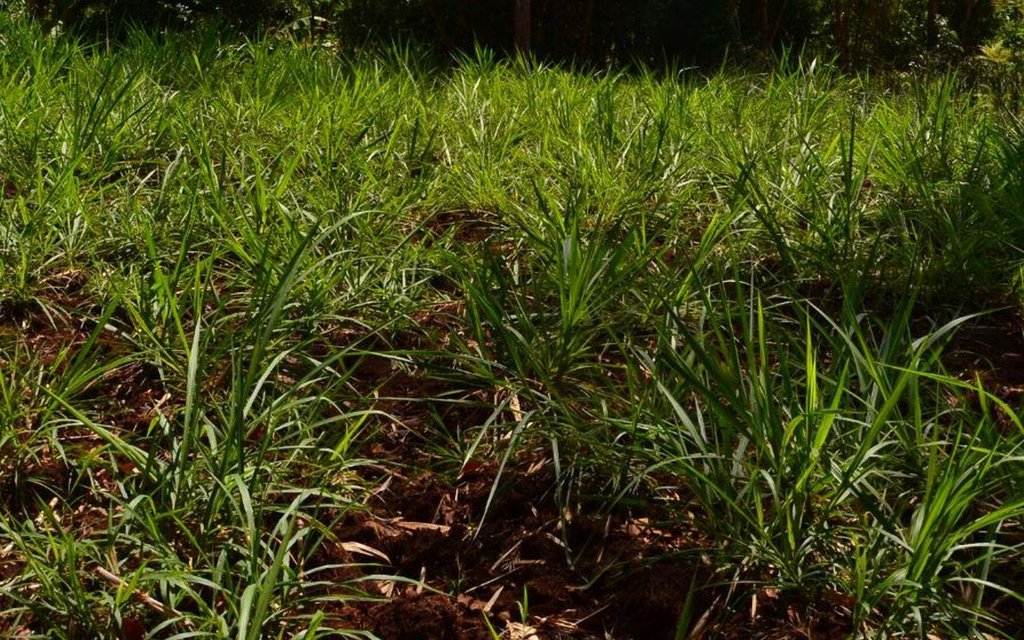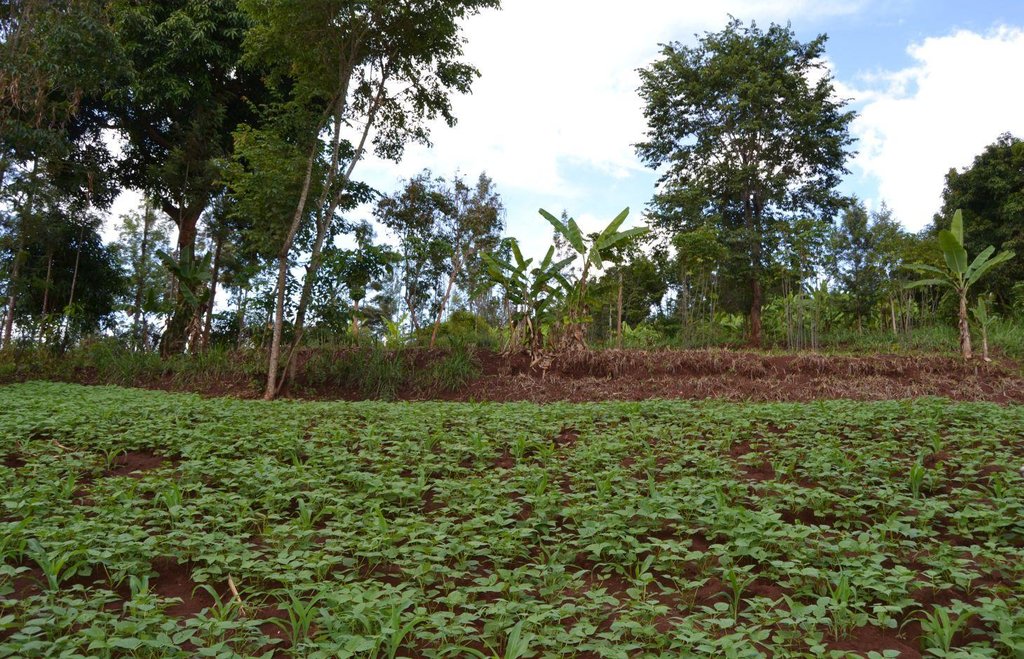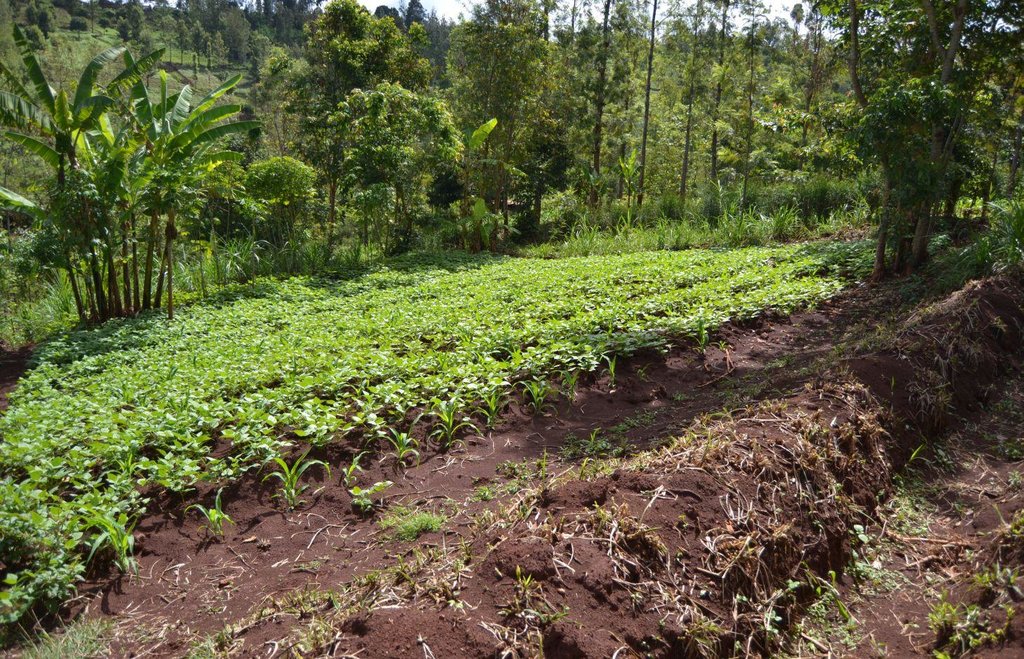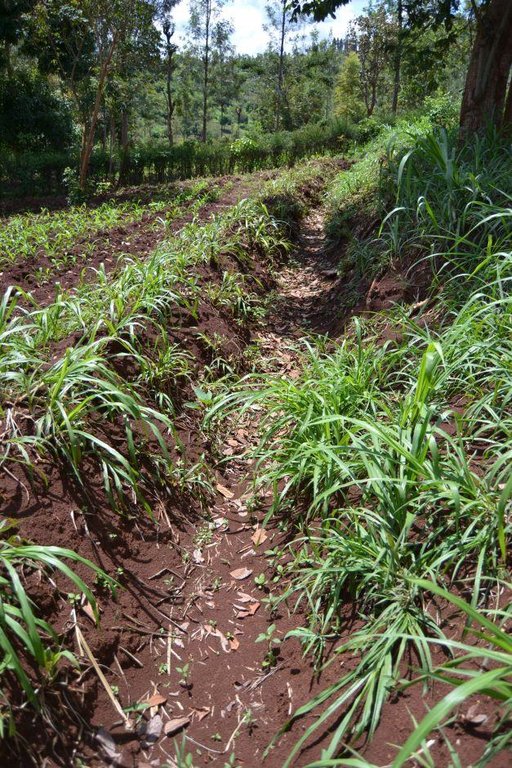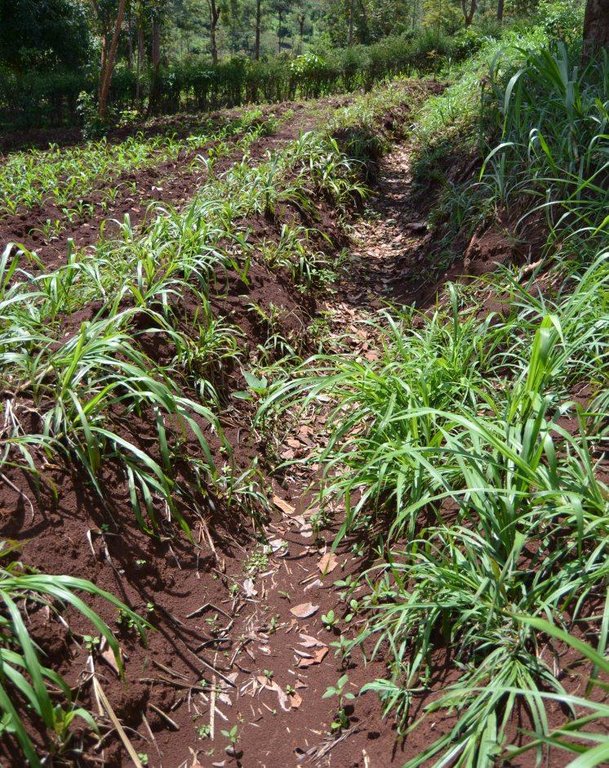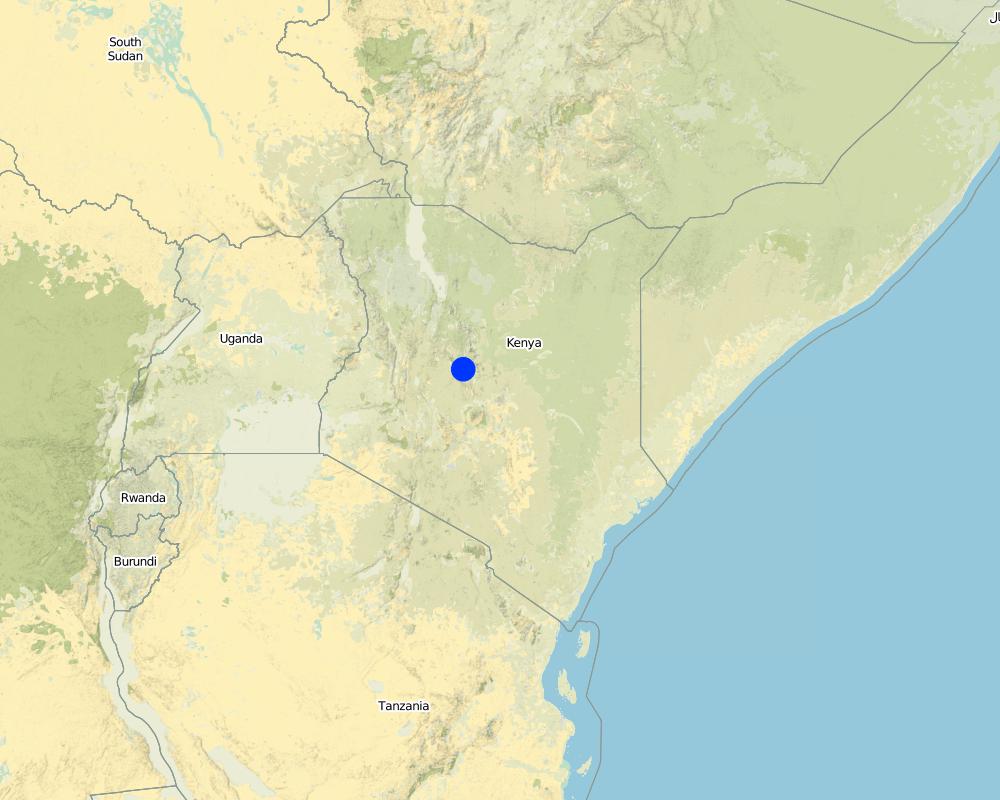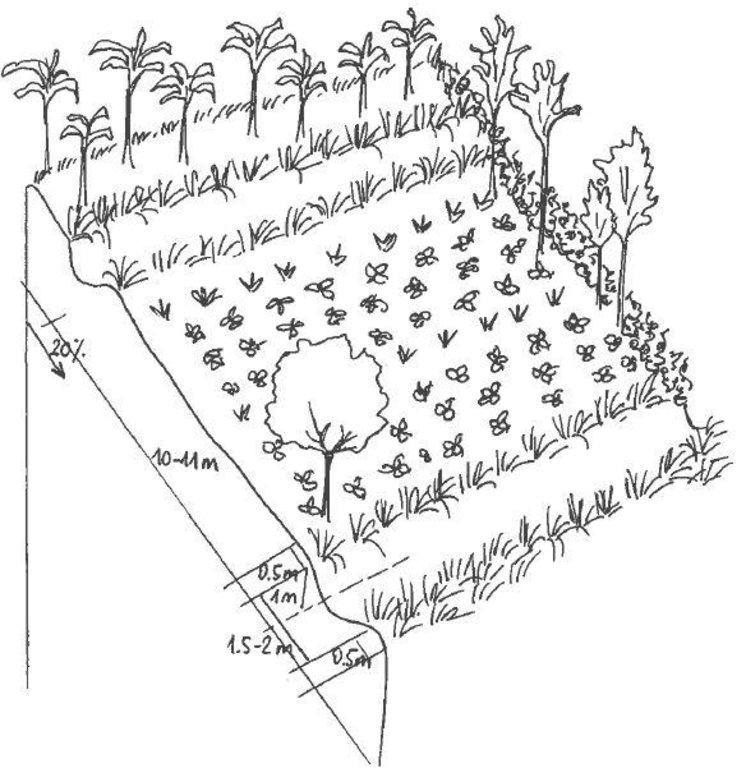Agroforestry system (intercropping beans/maize) with contour ditches, strips of Napier grass, manure and organic fertilizers. [Quênia]
- Criação:
- Atualização:
- Compilador/a: Laura D'Aietti
- Editor: –
- Revisores: Alexandra Gavilano, Fabian Ottiger
technologies_1146 - Quênia
- Resumo completo em PDF
- Resumo completo em PDF para impressão
- Resumo completo no navegador
- Resumo completo (sem formatação)
- Agroforestry system (intercropping beans/maize) with contour ditches, strips of Napier grass, manure and organic fertilizers.: 28 de Dezembro de 2016 (inactive)
- Agroforestry system (intercropping beans/maize) with contour ditches, strips of Napier grass, manure and organic fertilizers.: 5 de Junho de 2017 (inactive)
- Agroforestry system (intercropping beans/maize) with contour ditches, strips of Napier grass, manure and organic fertilizers.: 7 de Maio de 2019 (public)
Veja as seções
Expandir tudo Recolher tudo1. Informação geral
1.2 Detalhes do contato das pessoas capacitadas e instituições envolvidas na avaliação e documentação da tecnologia
Pessoa(s) capacitada(s)
Especialista em GST:
Nyamu Joseph
WRUA Sabasaba
Quênia
1.3 Condições em relação ao uso da informação documentada através de WOCAT
O/a compilador/a e a(s) pessoa(s) capacitada(s) aceitam as condições relativas ao uso de dados documentados através da WOCAT:
Sim
2. Descrição da tecnologia de GST
2.1 Descrição curta da tecnologia
Definição da tecnologia:
The technology is a combination of agricultural (e.g. intercropping, manure/compost/mulching), vegetative (e.g. Napier grass strips, trees planting) and structural (e.g. ditches) measures which aim to maximise the overall land yield in a sustainable manner (e.g. reducing soil erosion and increasing soil quality).
2.2 Descrição detalhada da tecnologia
Descrição:
The Agroforestry system combines trees plantation (Bananas, Grevillea and Avocados) for fruits and timber collection with cereal crop, maize (Zea mays). Indeed, in order to increase yields, strip intercropping is practiced: cereal crop (maize) is grown in association with pulse (food legumes): beans. Instead of using expensive commercial fertilizers, beans could facilitate maize growth due to the possible transfer of N during growth or after incorporation of the legume biomass, during the growth period of the cereal (Sangakkara et al., 2003). Furthermore, soil quality (e.g. soil structure) is improved because of the increased amount of humus and organic matter and a better soil cover helps in preventing splash erosion and increase soil moisture content and therefore fertility. Indeed, beans have a beneficial impact for weed control (probably due to the shadow effects) and soil moisture content (Worfswinkel, undated; Odhiambo and Ariga, 2001). Planting different crops helps to diversify production and family food supply. Concerning SWC, hillside ditches have been created at the top of each 'terrace' and trees are also planted nearby and Cassava (a drought resistant plant) at the bottom. Manure/compost and organic fertilizers are supplied regularly both on maize/grass (twice a year) and Bananas (once), as good soil management practice. A higher level of organic matter in the soil indicates reduced bulk density, improved soil structure, aeration and higher water holding capacity (Olabode et al., 2007), which altogether improve the physical, chemical and biological properties of the soil (Haering and Evanylo, 2005). Bananas are planted in lines in the upper part of the land. The ditches, large 1m are excavated along the contour; they break slope into shorter segments 11 m long to intercept surface runoff. Ditches also help to prevent soil erosion and to avoid that nutrients and organic matter flow easily downwards into the river, instead they fall into the ditch. A live barrier of Napier grass is present above and below the edge of the five ditches, in two lines, to capture sediments and stabilize the structure, thus it is adequately protected. To conclude, a small area of the land is used to plant Napier grass only for fodder for grazing
Purpose of the Technology: Maize and beans are cultivated for home consumption while Avocados and Bananas are planted for economic (commercial) purposes. Fruits are sold out to the middle-men directly from the house (not at the market), to reduce costs (e.g. transport) and time. Avocados are sold at about 2.5/3 Ksh and Bananas at 200 Ksh. Grevillea trees are considered as saving, and sold out for timber production when the farmer is in need of cash, earning between 800 up to 1500 Ksh, depending on the size-lenght of the tree and the costs for cutting-transportation (e.g. machine operator). In general the selling of timber occurs per feet (running feet). ‘Whole” or standing tree is the preferred mode of selling trees from farms. Negotiation on sales is per tree ‘standing on farm’, with no processing or conversion. Buyers cut and cross cut, and carry timber from farms. Branches and slabs resulting from timber recoveries are left with the farmer depending on price negotiation; if the buyer carries these products then the price of the tree is adjusted upwards (Carsan and Holding , 2006; Holding et al., undated). Furthermore, the farmer underlined how 'bad prunings' at the top of the trees cause holes inside the trunks and thus a higher risk of fungi attacks and other diseases. The majority of the trees are planted along the boundaries of the land, for demarcation and only few are 'dispersed' on the cropland, to avoid excess of shadow to the cereal crop
Establishment / maintenance activities and inputs: High initial input to construct ditches and planting crop; manure also requires regular work: feeding cows and collect droppings and distribute them twice during the year, also over Napier grass. Dry planting is the preferred practice and the seeds are soaked the night before planting; this practice is advisable especially when the growing period is very short (Schmidt et al., 1983); organic fertilizers are applied over maize after 1 week and during the growing period (after about 18 days). Further maintenance is necessary after every rainy season to remove the sediments accumulated into the ditch and for pruning Grevillea, every three seasons. As mentioned above, pruning requires skills and knowledge to avoid plant diseases and labour is expensive because it is high risk work. The farmer trees plantation account for: 15 Avocados (from 4 seedlings), 100 Bananas (from cutting new suckers) and 50 Grevillea trees
Natural / human environment: The area is characterized by rolling-hilly slope and highly exposed to erosion and land degradation: planting trees protect the soil from nutrients leaching and create a litter which reduces evaporation during dry seasons. Concerning the variety of the trees, (e.g. Avocado) the farmer by grafting with better quality branches, improve the quality of the stock trees with certified variesties: out of 4 seedlings of Avocado (10 Ksh each), he has now 15 seedlings of the better (certified) variety called HASS, which performs well at 800-2100 m asl with well distributed annual rainfall of 1000-1200 mm (Youth Agro-environmental initiative website)
2.3 Fotos da tecnologia
2.5 País/região/locais onde a tecnologia foi aplicada e que estão cobertos nesta avaliação
País:
Quênia
Região/Estado/Província:
Central
Especificação adicional de localização:
Muthithi location, Kagurumo sublocation
Especifique a difusão da tecnologia:
- Uniformemente difundida numa área
Se a Tecnologia estiver uniformemente distribuída por uma área, especifique a área coberta (em km2):
0,008
Se a área precisa não for conhecida, indicar a área aproximada coberta:
- < 0,1 km2 (10 ha)
Comentários:
Total area covered by the SLM Technology is 0.008 km2.
GATWAMIKWA village
Map
×2.6 Data da implementação
Caso o ano exato seja desconhecido, indique a data aproximada:
- menos de 10 anos atrás (recentemente)
2.7 Introdução da tecnologia
Especifique como a tecnologia foi introduzida:
- atráves de inovação dos usuários da terra
Comentários (tipos de projeto, etc.):
Since the year 2000 the farmer adopted SWC practices in respond to the prolonged degraded situation of the land and its low yields.
3. Classificação da tecnologia de GST
3.2 Tipo(s) atualizado(s) de uso da terra onde a tecnologia foi aplicada
Uso do solo misturado dentro da mesma unidade de terra:
Sim
Especificar o uso misto da terra (culturas/ pastoreio/ árvores):
- Agrossilvipecuária

Terra de cultivo
- Cultura anual
- Cultura perene (não lenhosa)
- Cultura de árvores e arbustos
Cultivo anual - Especificar culturas:
- cereais - milho
- culturas forrageiras - gramíneas
- Legumes e leguminosas - feijão
Cultivo perene (sem lã) - Especificar culturas:
- banana/planta/abacá
Cultivo de árvores e arbustos - Especificar culturas:
- abacate
Número de estações de cultivo por ano:
- 2
Especifique:
Longest growing period in days: 122Longest growing period from month to month: from about March to JuneSecond longest growing period in days: 61Second longest growing period from month to month: from about October to November
O cultivo entre culturas é praticado?
Sim
Em caso afirmativo, especifique quais são as culturas intercultivadas:
Intercropping of maize and beans: the distance from one line of maize and the other is of 1m.

Pastagem
Pastagem intensiva/produção de forragem:
- Semiestabulação/sem pastagem
- cows

Floresta/bosques
- Plantação de árvores, reflorestamento
Tipo de árvore:
- Grevillea robusta
Produtos e serviços:
- Madeira
- Frutas e nozes
Comentários:
Trees/ shrubs species: Grevillea (Grevillea robusta)
Fruit trees / shrubs species: Avocados (Persea americana- Mũkorobia), Bananas (Musa sapientum- Irigũ)
Grass species: Pennisetum pyramidalis (Napier grass or elephant grass)
Main crop: Maize (Zea mays) and beans
Main animal species and products: Cut-and-carry/ zero grazing: Fodder is provided to animals (2 cows) confined to a stall.
Major land use problems (compiler’s opinion): Sheet erosion with consequent nutrient leaching which could drain into the river.
Major land use problems (land users’ perception): Loss of soil fertility.
Grazingland comments: Fig. 10 Annex 3
Plantation forestry: Yes
Type of grazing system comments: Fig. 10 Annex 3
Livestock density: < 1 LU/km2
3.4 Abastecimento de água
Abastecimento de água para a terra na qual a tecnologia é aplicada:
- Precipitação natural
3.6 Medidas de GST contendo a tecnologia

Medidas agronômicas
- A1: cobertura vegetal/do solo
- A2: Matéria orgânica/fertilidade do solo
- A3: Tratamento da superfície do solo

Medidas vegetativas
- V1: cobertura de árvores/arbustos
- V2: gramíneas e plantas herbáceas perenes

Medidas estruturais
- S4: Valas de nível, fossos
Comentários:
Main measures: vegetative measures, structural measures
Secondary measures: agronomic measures
Type of agronomic measures: mulching, legume inter-planting, manure / compost / residues
Type of vegetative measures: aligned: -graded strips *<sup>3</sup>
3.7 Principais tipos de degradação da terra abordados pela tecnologia

Erosão do solo pela água
- Wt: Perda do solo superficial/erosão de superfície

Deteriorização química do solo
- Cn: declínio de fertilidade e teor reduzido de matéria orgânica (não causado pela erosão)

Degradação da água
- Hp: declínio da qualidade de água de superfície
Comentários:
Main causes of degradation: soil management (Poor soil management practices.), deforestation / removal of natural vegetation (incl. forest fires) (Poor vegetation cover, mainly herbaceous), disturbance of water cycle (infiltration / runoff) (Steep area (runoff)), Heavy / extreme rainfall (intensity/amounts) (Especially during wet seasons: March-June and October-November), education, access to knowledge and support services (Limited knowledge and training on SWC practices), governance / institutional (Limited or not adequate support)
Secondary causes of degradation: other natural causes (avalanches, volcanic eruptions, mud flows, highly susceptible natural resources, extreme topography, etc.) specify (From gentle to hilly slope), land tenure (Previous poor management SWC measures, especially in the upper areas)
3.8 Redução, prevenção ou recuperação da degradação do solo
Especifique o objetivo da tecnologia em relação a degradação da terra:
- Prevenir degradação do solo
- Reduzir a degradação do solo
4. Especificações técnicas, implementação de atividades, entradas e custos
4.1 Desenho técnico da tecnologia
Especificações técnicas (relacionada ao desenho técnico):
Agroforestry system, which covers an area of 2 acre. The plot is bordered by Euphorbia tirucalli (Kariaria, milk bush) and Grevillea trees. The ditches are characterized by barriers of Napier grass. Intercropping of maize and beans: the distance from one line of maize and the other is of 1m.
Technical knowledge required for land users: moderate
Main technical functions: control of dispersed runoff: retain / trap, control of dispersed runoff: impede / retard, reduction of slope angle, reduction of slope length, improvement of ground cover, increase of infiltration, increase / maintain water stored in soil, water harvesting / increase water supply, sediment retention / trapping, sediment harvesting
Secondary technical functions: improvement of topsoil structure (compaction), stabilisation of soil (eg by tree roots against land slides), increase in organic matter, increase in nutrient availability (supply, recycling,…), improvement of water quality, buffering / filtering water, increase of biomass (quantity)
Mulching
Material/ species: Organic residues around Banana trees
Quantity/ density: undefined
Legume inter-planting
Quantity/ density: 4 kg
Manure / compost / residues
Material/ species: Leftovers and manure from two cows
Quantity/ density: 8 tonnes
Remarks: (for 1 year). The mix of organic material is left decomposed in a big hole.
Agronomic measure: organic fertilizers
Material/ species: Acid humic and N, P, K, microelements (Biodeposit Elixir: small bags (sachets) of 12 ml)
Remarks: 5 bags (1×12 litre), applied only on maize
Aligned: -graded strips
Vegetative material: T : trees / shrubs, F : fruit trees / shrubs, G : grass
Number of plants per (ha): 100 a strip
Vertical interval between rows / strips / blocks (m): few cm
Spacing between rows / strips / blocks (m): 1
Vertical interval within rows / strips / blocks (m): 0.25
Width within rows / strips / blocks (m): 1
Trees/ shrubs species: Grevillea (Grevillea robusta)
Fruit trees / shrubs species: Avocados (Persea americana- Mũkorobia), Bananas (Musa sapientum- Irigũ)
Grass species: Pennisetum pyramidalis (Napier grass or elephant grass)
Slope (which determines the spacing indicated above): 10%
If the original slope has changed as a result of the Technology, the slope today is (see figure below): 15%
Gradient along the rows / strips: 5-8%
Diversion ditch/ drainage
Spacing between structures (m): 1
Depth of ditches/pits/dams (m): 40/50
Width of ditches/pits/dams (m): 0.6/1
Slope (which determines the spacing indicated above): 5-8%
Lateral gradient along the structure: 15-20%
Autor:
D'Aietti Laura
4.2 Informação geral em relação ao cálculo de entradas e custos
Outro/moeda nacional (especifique):
Kenyan Schellings
Se for relevante, indique a taxa de câmbio do USD para moeda local (por exemplo, 1 USD = 79,9 Real): 1 USD =:
85,9
Indique a média salarial da mão-de-obra contratada por dia:
2.00
4.3 Atividades de implantação
| Atividade | Periodicidade (estação do ano) | |
|---|---|---|
| 1. | Digging holes (1 feet ×1 feet) and planting trees (e.g. Grevillea trees along the boundaries and in line below the bunds of the ditches) | March (before rains), 1 year |
| 2. | Establishment of the ditches(digging ditch and creating soil bunds donward) and terracing. For 1 (in tot. are 5) : 2 p.d. * 1 day at 200 Ksh a day each. | 2 times per year |
| 3. | Digging the hole (3m×3m×1.5m) where to compost | |
| 4. | Machine to grill/mill maize leftovers (chap cutter) | |
| 5. | Purchase 2 cows | |
| 6. | Purchase generator |
Comentários:
Life span of the machine to grill, the cows and the generator: Several years
4.4 Custos e entradas necessárias para a implantação
| Especifique a entrada | Unidade | Quantidade | Custos por unidade | Custos totais por entrada | % dos custos arcados pelos usuários da terra | |
|---|---|---|---|---|---|---|
| Mão-de-obra | Digging the hole (3m×3m×1.5m) where to compost | person/days | 2,0 | 3,5 | 7,0 | 100,0 |
| Mão-de-obra | Digging holes (1 feet ×1 feet) and planting trees | person/days | 2,0 | 3,5 | 7,0 | 100,0 |
| Mão-de-obra | Establishment of the ditches (digging ditch and creating soil bunds donward) and terracing | person/days | 10,0 | 23,3 | 233,0 | 100,0 |
| Equipamento | Machine to grill/mill maize leftovers (chap cutter) | piece | 1,0 | 1164,0 | 1164,0 | 100,0 |
| Equipamento | Generator | piece | 1,0 | 582,0 | 582,0 | 100,0 |
| Equipamento | Cow | piece | 2,0 | 349,0 | 698,0 | 100,0 |
| Material vegetal | Seedlings Grevillea | pieces | 54,0 | 0,1111 | 6,0 | 100,0 |
| Custos totais para a implantação da tecnologia | 2697,0 | |||||
| Custos totais para o estabelecimento da Tecnologia em USD | 31,4 | |||||
Comentários:
Duration of establishment phase: 6 month(s)
4.5 Atividades recorrentes/manutenção
| Atividade | Periodicidade/frequência | |
|---|---|---|
| 1. | Prepare and apply fertilizers (organic) (See Annex 3, Fig. 9&comments) | Ferlizer application: after 1 week and 18 days, on maize only |
| 2. | Prepare manure+compost/mulch (Summary 2.1.2 QT4): Labour (to grill/mill leftovers - 300 Ksh for fuel- leftovers to prepare food for cows-3 person days) rest, the farmer by himself feed cows on daily basis (3 times in a day). Fuel: 1litre×1 day (×3 days) | compost/manure: 2 times/year in the field+grass; once on Bananas (where also added mulch) |
| 3. | Harvesting maize/beans (around Feb/March and Ag/Sept) | 2 times |
| 4. | Apply manure, mulch and compost (during March/April-long rains+Sept) just before the rains, when nutrients infiltrate into the soil with rainwater) (Summary 2.1.2 QT4) | Compost/manure: 2 times/year in the field+grass; once on Bananas (where also added mulch) |
| 5. | Tilling-soil (digging holes to plant maize/beans: 7 inches deep (17cm), spaced 1 feet (0.30 m) in contours: dry planting (before rains starts) | Twice a year, before rainy season (around March/Sept) |
| 6. | Digging planting holes and planting grass (2 persons × 3 days: 200 Ksh) | Every season (March/April and Sept/Oct) |
| 7. | Maintenance (weed control and cutting Napier grass and collecting fodder) (Fig. 11 Annex 3) | Every season (March/Sept); cutting Napier: 3/4 times in a season |
| 8. | Pruning branches and let them dry for firewood | Every 3 seasons (and when shortage of firewood) |
| 9. | Clearing the tree for selling timber (the price depends also of the use of the chainsaw (or saw) or not | When in need of cash (not regularly), not less than 5 years after planting |
| 10. | Repairing the ditches and remove excess of soil/leaves accumulated during the rainy season | After rains (every season) |
4.6 Custos e entradas necessárias pata a manutenção/atividades recorrentes (por ano)
| Especifique a entrada | Unidade | Quantidade | Custos por unidade | Custos totais por entrada | % dos custos arcados pelos usuários da terra | |
|---|---|---|---|---|---|---|
| Mão-de-obra | Prepare and apply fertilizers (organic) | person/days | 2,0 | 2,0 | 4,0 | 100,0 |
| Mão-de-obra | Prepare manure+compost/mulch | person/days | 3,0 | 2,0 | 6,0 | 100,0 |
| Mão-de-obra | Digging planting holes and planting grass | person/days | 6,0 | 2,0 | 12,0 | 100,0 |
| Mão-de-obra | Maintenance (weed control and cutting Napier grass and collecting fodder) | person/days | 5,0 | 12,0 | 60,0 | 100,0 |
| Equipamento | Fuel | l | 3,0 | 1,0 | 3,0 | 100,0 |
| Material vegetal | Seedlings grass (per ha) | pieces | 100,0 | |||
| Fertilizantes e biocidas | Organic fertilizer (Biodeposit Elixir) from Thika | ml | 12,0 | 1,0 | 12,0 | 100,0 |
| Outros | Labour: Pruning branches and let them dry for firewood | person/days | 1,0 | 4,0 | 4,0 | 100,0 |
| Outros | Labour: Clearing the tree for selling timber | person/days | 1,0 | 7,0 | 7,0 | 100,0 |
| Outros | Labour: Repairing the ditches and remove excess of soil/leaves accumulated during the rainy season | person/days | 2,0 | 2,0 | 4,0 | 100,0 |
| Custos totais para a manutenção da tecnologia | 112,0 | |||||
| Custos totais de manutenção da Tecnologia em USD | 1,3 | |||||
Comentários:
Machinery/ tools: the farmer prefers to use fork djembe then just the normal djembe (because it removes better the soil); panga and hoes, shovel, fork djembe, panga, saw, shovels
The costs has been computed during the period of the field visit and it include all the costs for the different structures: agronomic, vegetative and structural measures for 2 acre of land and summarized for 1 year period.
4.7 Fatores mais importantes que afetam os custos
Descreva os fatores mais determinantes que afetam os custos:
The main environmental constrain is water, in particular during dry season; An important cost is labour required to maintain all the SWC measures.
5. Ambiente natural e humano
5.1 Clima
Precipitação pluviométrica anual
- <250 mm
- 251-500 mm
- 501-750 mm
- 751-1.000 mm
- 1.001-1.500 mm
- 1.501-2.000 mm
- 2.001-3.000 mm
- 3.001-4.000 mm
- > 4.000 mm
Zona agroclimática
- Subúmido
Thermal climate class: subtropics. June, July and August
5.2 Topografia
Declividade média:
- Plano (0-2%)
- Suave ondulado (3-5%)
- Ondulado (6-10%)
- Moderadamente ondulado (11-15%)
- Forte ondulado (16-30%)
- Montanhoso (31-60%)
- Escarpado (>60%)
Formas de relevo:
- Planalto/planície
- Cumes
- Encosta de serra
- Encosta de morro
- Sopés
- Fundos de vale
Zona de altitude:
- 0-100 m s.n.m.
- 101-500 m s.n.m.
- 501-1.000 m s.n.m.
- 1.001-1.500 m s.n.m.
- 1.501-2.000 m s.n.m.
- 2.001-2.500 m s.n.m.
- 2.501-3.000 m s.n.m.
- 3.001-4.000 m s.n.m.
- > 4.000 m s.n.m.
5.3 Solos
Profundidade do solo em média:
- Muito raso (0-20 cm)
- Raso (21-50 cm)
- Moderadamente profundo (51-80 cm)
- Profundo (81-120 cm)
- Muito profundo (>120 cm)
Textura do solo (solo superficial):
- Médio (limoso, siltoso)
Matéria orgânica do solo superficial:
- Baixo (<1%)
5.4 Disponibilidade e qualidade de água
Lençol freático:
> 50 m
Disponibilidade de água de superfície:
Médio
Qualidade da água (não tratada):
Água potável boa
5.5 Biodiversidade
Diversidade de espécies:
- Médio
5.6 Características dos usuários da terra que utilizam a tecnologia
Rendimento não agrícola:
- >50% de toda renda
Nível relativo de riqueza:
- Rico
Indivíduos ou grupos:
- Indivíduo/unidade familiar
Nível de mecanização:
- Trabalho manual
Indique outras características relevantes dos usuários da terra:
Population density: 10-50 persons/km2
Annual population growth: 2% - 3%
Off-farm income specification: The farmer is rich because he owns 3 acre of land and livestock, assets (electricity) which are above the average standards of the community. The farmer is retired from an accountancy service position several years ago.
Market orientation of production system: subsistence (self-supply), subsistence (self-supply), commercial/ market
5.7 Área média de terrenos utilizados pelos usuários de terrenos que aplicam a Tecnologia
- < 0,5 ha
- 0,5-1 ha
- 1-2 ha
- 2-5 ha
- 5-15 ha
- 15-50 ha
- 50-100 ha
- 100-500 ha
- 500-1.000 ha
- 1.000-10.000 ha
- > 10.000 ha
5.8 Propriedade de terra, direitos de uso da terra e de uso da água
Propriedade da terra:
- Indivíduo, intitulado
Direitos do uso da terra:
- Indivíduo
Direitos do uso da água:
- Acesso livre (não organizado)
Comentários:
Water use rights depend on the use: open access for drinking and domestic uses.
5.9 Acesso a serviços e infraestrutura
Saúde:
- Pobre
- Moderado
- Bom
Educação:
- Pobre
- Moderado
- Bom
Assistência técnica:
- Pobre
- Moderado
- Bom
Emprego (p. ex. não agrícola):
- Pobre
- Moderado
- Bom
Mercados:
- Pobre
- Moderado
- Bom
Energia:
- Pobre
- Moderado
- Bom
Vias e transporte:
- Pobre
- Moderado
- Bom
Água potável e saneamento:
- Pobre
- Moderado
- Bom
Serviços financeiros:
- Pobre
- Moderado
- Bom
6. Impactos e declarações finais
6.1 Impactos no local mostrados pela tecnologia
Impactos socioeconômicos
Produção
Produção agrícola
Produção de madeira
Renda e custos
Despesas com insumos agrícolas
Rendimento agrícola
Impactos socioculturais
Situação de grupos social e economicamente desfavorecidos
Impactos ecológicos
Ciclo hídrico/escoamento
Escoamento superficial
Evaporação
Solo
Umidade do solo
Cobertura do solo
Perda de solo
Biodiversidade: vegetação, animais
Biomassa/carbono acima do solo
6.2 Impactos externos mostrados pela tecnologia
Disponibilidade de água
Capacidade de tamponamento/filtragem
6.3 Exposição e sensibilidade da tecnologia às mudanças climáticas graduais e extremos/desastres relacionados ao clima (conforme o ponto de vista dos usuários da terra)
Mudança climática gradual
Mudança climática gradual
| Estação do ano | aumento ou diminuição | Como a tecnologia lida com isso? | |
|---|---|---|---|
| Temperatura anual | aumento | não conhecido |
Extremos (desastres) relacionados ao clima
Desastres meteorológicos
| Como a tecnologia lida com isso? | |
|---|---|
| Temporal local | bem |
| Tempestade de vento local | bem |
Desastres climatológicos
| Como a tecnologia lida com isso? | |
|---|---|
| Seca | não bem |
Desastres hidrológicos
| Como a tecnologia lida com isso? | |
|---|---|
| Inundação geral (rio) | bem |
Outras consequências relacionadas ao clima
Outras consequências relacionadas ao clima
| Como a tecnologia lida com isso? | |
|---|---|
| Período de crescimento reduzido | não conhecido |
6.4 Análise do custo-benefício
Como os benefícios se comparam aos custos de implantação (do ponto de vista dos usuários da terra)?
Retornos a curto prazo:
levemente negativo
Retornos a longo prazo:
levemente positivo
Como os benefícios se comparam aos custos recorrentes/de manutenção(do ponto de vista dos usuários da terra)?
Retornos a curto prazo:
levemente positivo
Retornos a longo prazo:
positivo
6.5 Adoção da tecnologia
Comentários:
100% of land user families have adopted the Technology without any external material support
There is a moderate trend towards spontaneous adoption of the Technology
6.7 Pontos fortes/vantagens/oportunidades da tecnologia
| Pontos fortes/vantagens/oportunidades na visão do usuário da terra |
|---|
| Better yields thanks to the intercropping measures taken. |
| Pontos fortes/vantagens/oportunidades na visão do/a compilador/a ou de outra pessoa capacitada |
|---|
|
Intercropping is a commonly known practice which improves the overall conditions of the soil and provide better yields. How can they be sustained / enhanced? Besides 'companion planting' there are plants which can be grown as forerunner plants (Storey, 2002). Depending also on the type of soil, attention could be given to some sps. which accumulate concentration of e.g. mineral accumulators, phosporus, potassium, calcium, silica and sulphur . Another way to perhaps enhance the yields is relay intercropping. It is undersowing the next crop into the present crop, so that the present crop is a nurse crop and time and water is saved in the establishment of the following crop (Storey, 2002) Green manure as a way to add organic nutrients and combine more than one green manure and rotate, both legume (e.g. cowpeas, soybeans, annual sweet clover, vetch, sesbania, and velvet beans ) and not legume (e.g. sudangrass, millet, sorghum, and buckwheat). |
|
Agroforestry (Dispersed trees on cropland): The technology is simple to adopt and improves a sustainable land management as well as diversification of income sources and food supply. How can they be sustained / enhanced? It could be implemented by increasing the number of trees planted (e.g. along the boundaries) and with sps. characterised by deeper root systems, to avoid further water competition. More Avocadoe trees could increase the opportunities for the farmer to be part of a CBO (Community Based Organization) addressed to marketing of Avocadoes for oil production. This could help the farmer to earn more money and invest more in SWC implementation and new methods, in the long run. The option of alley cropping (hedgerow Intercropping) with leguminous plants e.g. Sesbanian sesban (Ramachandran Nair-ICRAF, 1993) could be considered as another option. |
|
Napier grass has very good properties in holding soil; also for ditch stabilization and fodder production How can they be sustained / enhanced? Other herbaceous vegetation could be also planted in the field: e.g. Tithonia diversifolia (Mexican sunflower), an excellent (high quality-N, P, K concentration) green manure /nutrient release and medicinal plant, or could be also used as a major component of compost manure. It is an annual weed that can be used for several purposes: fodders, poultry feed, fuel, compost, land demarcation, soil erosion, building materials, shelter for poultry. It is characterized by adaptability to different environment, rapid growth, fast rate of decomposition. Nevertheless, there is the need to ascertain the extent to which this weed sps. could be used for soil improvement and to determine the best mode of application of the weed sps., (Olabode et al., 2007, Olubukola et al., 2013) and the fact that is a invasive weed (with an aggressive growth) it requires a good knowledge in the land management and weed control. |
| The attention to certified varieties give also more value to the production itself and at market level: an increase of the bargaining power creates more opportunities for better income and chances to explore new and bigger markets, (e.g. Avocados for oil production ). |
6.8 Pontos fracos, desvantagens/riscos da tecnologia e formas de superá-los
| Pontos fracos/vantagens/riscos na visão do/a compilador/a ou de outra pessoa capacitada | Como eles podem ser superados? |
|---|---|
| The technologies in place require maintenance and monitoring, especially during rainy seasons | Eventually subsides or be part of a CBO's (Community Based Organizations) or SHG (Self Help Groups); Still the measures already in place could be improved: diversification of trees (e.g. indigenous) and trainings (e.g. pruning etc) could help the farmer in avoiding tree diseases and allocate more efficiently resources. |
| The amount of work required to carry out all the activities is too much. |
7. Referências e links
7.1 Métodos/fontes de informação
7.2 Referências às publicações disponíveis
Título, autor, ano, ISBN:
Holding C., Carsan S., Njuguna P., 2004. Smallholder Timber Marketing: A Kenyan Experience. FAO/ICRAF/GoK multi-stakeholder programme. International Workshop on small holder timber production.
Título, autor, ano, ISBN:
Odhiambo G.D. and Ariga E. S., 2001. Effect of intercropping maize and beans on Striga incidence and grain yield. Seventh Eastern and Southern Africa Regional Maize Conference. 11th -15 th February, 2001. pp. 183-186.
Título, autor, ano, ISBN:
Olabode O.S., Sola O., Akanbi W.B., Adesina G.O., Babajide P.A., 2007. Evaluation of Tithonia diversifolia (Hemsl.) A Gray for Soil Improvement. World Journal of Agricultural Sciences 3 (4): 503-507.
Disponível de onde? Custos?
http://www.idosi.org/wjas/wjas3(4)/15.pdf
Título, autor, ano, ISBN:
Olubukola S. A., Aderemi Ojo Ezekiel-Adewoyin O., Dorcas Tinuke D., Akintoye Henry, 2010. Comparing the use of Tithonia diversifolia and Compost as soil amendments for growth and yield of Celosia argentea. New York Science Journal 3 (6).
Disponível de onde? Custos?
http://www.sciencepub.net/newyork/ny0306/20_2680_ny0306_133_138.pdf
Título, autor, ano, ISBN:
Ramachandran Nair P. K., 1993. An Introduction to Agroforestry- ICRAF.
Disponível de onde? Custos?
http://www.worldagroforestry.org/units/library/books/PDFs/32_An_introduction_to_agroforestry.pdf?n=161
Título, autor, ano, ISBN:
Sanchez M. A., 2012. Food vs wood: dynamic choices for Kenyan smallholders. A plan B research paper. Master of Science. Michigan State University.
Disponível de onde? Custos?
http://ageconsearch.umn.edu/bitstream/134024/2/PeraltaSanchezPlanB.pdf
Título, autor, ano, ISBN:
Sangakkara U.R., Richner W., Schneider M. K., Stamp P., 2003. Impact of intercropping beans (Phaseolus vulgaris L.) and sunhemp (Crotalaria juncea L.) on growth yields and Nitrogen uptake of maize (Zea mays L.) grown in the humid tropics during the minor rainy season. Maydica 48: 233-238
Disponível de onde? Custos?
http://www.maydica.org/articles/48_233.pdf
Título, autor, ano, ISBN:
Schmidt H., Swoboda R., Ralph Jätzold R., 1983. Farm Management Handbook of Kenya. Natural Conditions and Farm Management Information. Vol. 2.Part B: Central Kenya
Disponível de onde? Custos?
http://www2.gtz.de/dokumente/bib/07-1284.pdf
Título, autor, ano, ISBN:
Smith D. M., Jackson N. A., Roberts J.M. and Ong C.K., 1999. Root distributions in a Grevillea robusta-maize agroforestry system in semi-arid Kenya. Plant and Soil 211: 191–205, 1999.
Título, autor, ano, ISBN:
Storey P. J., 2002. The conservation and improvement of sloping land. Volume 1: Practical understanding. Chapter 5: Improving the soil management.
Título, autor, ano, ISBN:
Worfswinkel van M., undated. Intercropping of Annual Foodcrops, Agrobrief (Agromisa), N.4
Disponível de onde? Custos?
http://www.allindiary.org/pool/resources/intercropping.pdf
Título, autor, ano, ISBN:
Carsan S., Holding C., 2006. Growing farm timber: practices, market and policies. The Meru timber marketing pilot programme case studies and reviews. World Agroforestry Centre.
Disponível de onde? Custos?
http://www.worldagroforestry.org/downloads/publications/PDFs/b14639.pdf
Título, autor, ano, ISBN:
Chia-Chun Wu, 1998. Effective conservation practices for the cultivation of slopelands, Extension Bulletin (ASPAC/FFTC), No. 449, 7 p.
Disponível de onde? Custos?
http://www.fao.org/prods/gap/database/gap/files/1272_CONSERVATION_ON_SLOPES.PDF
Título, autor, ano, ISBN:
Crozier C., 1986. Soil Conservation Techniques for Hillside Farms. A Guide for Peace Corps Volunteers. Appropriate Technologies for Development. Peace Corps Information Collection & Exchange Reprint Series No. R-62. Peace Corps Institution.
Disponível de onde? Custos?
(The Humanity Development Library website: http://www.nzdl.org/gsdlmod?a=p&p=home&l=en&w=utf-8)
Título, autor, ano, ISBN:
CSIRO (Baldock J.) Soil carbon: the basics. website (http://www.csiro.au/en/Outcomes/Environment/Australian-Landscapes/soil-carbon.aspx) . Also in: Carbon Farming Fact Sheet: Store carbon for healthy soils and better yields.
Disponível de onde? Custos?
http://www.grdc.com.au/uploads/documents/GRDC_CarbonFarming_4pp.pdf
Título, autor, ano, ISBN:
Elemans A., 2011. Thesis report (unpublished): Green water credits program in Saba Saba sub-catchment in the Upper Tana, Kenya.
Título, autor, ano, ISBN:
Gutteridge R. C. and Sheltong H. M., 1998.eridge R. C. and Shelton H. M., 1998. Forage tree legumes in tropical agriculture. (http://www.fao.org/ag/AGP/AGPC/doc/PUBLICAT/Gutt-shel/x5556e00.htm Chapter 5.2
Disponível de onde? Custos?
http://www.fao.org/ag/AGP/AGPC/doc/Publicat/Gutt-shel/x5556e0q.htm
Título, autor, ano, ISBN:
HDRA , undated. Agroforestry in the Tropics.
Disponível de onde? Custos?
http://www.thenrgroup.net/member/MRO/AER/AER-560.htm
Título, autor, ano, ISBN:
Haering, K., Evanylo G., 2005. Composting and Compost Use for Water Quality. In Composting resource directory. Mid-Atlantic Reg. Water Program.
Disponível de onde? Custos?
http://infohouse.p2ric.org/ref/41/40137.pdf
Título, autor, ano, ISBN:
Holding C., Carsan S., Njuguna P., undated. Smallholder timber and firewood marketing in the coffee and cotton/tobacco zones of eastern Mount Kenya. In: Small-scale forestry and rural development: The intersection of ecosystems, economics and society.
Disponível de onde? Custos?
http://www.coford.ie/media/coford/content/publications/projectreports/small-scaleforestryconference/Holding.pdf
Links e módulos
Expandir tudo Recolher tudoLinks
Não há links
Módulos
Não há módulos


